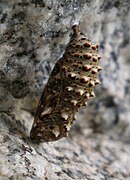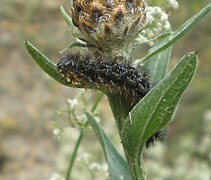You can help expand this article with text translated from the corresponding article in French. (August 2018) Click for important translation instructions.
|
| Knapweed fritillary | |
|---|---|

| |
| Male | |

| |
| Female | |
| Conservation status | |
 Least Concern (IUCN 3.1) | |
| Scientific classification | |
| Domain: | Eukaryota |
| Kingdom: | Animalia |
| Phylum: | Arthropoda |
| Class: | Insecta |
| Order: | Lepidoptera |
| Family: | Nymphalidae |
| Genus: | Melitaea |
| Species: | M. phoebe |
| Binomial name | |
| Melitaea phoebe (Denis & Schiffermüller, 1775) | |
| Synonyms | |
|
Papilio phoebe Denis & Schiffermüller, 1775 | |
Melitaea phoebe, also known as the knapweed fritillary, is a butterfly of the family Nymphalidae. It is found in the Palearctic realm, including most of Europe and North Africa, excluding the United Kingdom and Scandinavia. Previously, it also included Melitaea telona, which was recently revalidated as a distinct cryptic species.
Description
For a key to the terms used, see Glossary of entomology terms.M. phoebe butterflies have a wingspan of 34 to 50 mm. Their forewings are more pointed than the eastern knapweed fritillary, but are equally variable in color and distinctive markings. Their black markings are usually joined, but may instead cover a majority of the wing or very little of it.
The species features a reddish-yellow submarginal lunate (crescent-shaped) spot between the two median veins that reaches its vertex, considerably farther into the disc than the other yellow lunate spots. This pattern is present on both the forewings and the hindwings. Additionally, the submarginal lunule between the 1st and 2nd median veins projects farther basal than the other lunules of the same row. Wheeler (1903) gives a short description.
M. phoebe pupa are a dull yellow-brown colour, with dark yellow and black markings. The larvae are grey with a black head, soft red-brown branched thorns, blackish dorsal lines, and numerous small white dots.
Biology
M. phoebe is active from April to September, depending on the location. The larvae feed on Plantago and Centaurea species (including Centaurea jacea).
Distribution and habitat
M. phoebe is present throughout Europe except for the northern regions such as England, Ireland, Northern France, Germany, Poland, Holland, Belgium and Scandinavia. It can also be found in North Africa: Morocco and Algeria, Turkey, Siberia, and Central Asia in Mongolia and northern China included.
M. phoebe inhabits flowery meadows and plains, but may just also be found in stonier places such as rocky hills.
Etymology
Named in the classical tradition, Phoebe is—in Greek mythology—one of the first generation of Titans, the children of Uranus and Gaia. The species Melitaea phoebe was described by entomologists Johann Nepomuk Cosmas, Michael Denis and Ignaz Schiffermüller in 1779, under the initial name Papilio phoebe.
References
- ^ Melitaea phoebe. IUCN Red List.
- Savela, Markku. "Melitaea phoebe (Denis & Schiffermüller, 1775)". Lepidoptera and Some Other Life Forms. Retrieved 23 June 2018.
- ^ Seitz. A. in Seitz, A. ed. Band 1: Abt. 1, Die Großschmetterlinge des palaearktischen Faunengebietes, Die palaearktischen Tagfalter, 1909, 379 Seiten, mit 89 kolorierten Tafeln (3470 Figuren).
 This article incorporates text from this source, which is in the public domain.
This article incorporates text from this source, which is in the public domain.
- Wheeler, George. The butterflies of Switzerland and the alps of central Europe. London: Elliot Stock, 1903.
- Mazza, Giuseppe (7 August 2008). "Melitaea phoebe". Monaco Nature Encyclopedia. Retrieved 18 September 2024.
| Taxon identifiers | |
|---|---|
| Melitaea phoebe |
|
| Papilio phoebe | |






